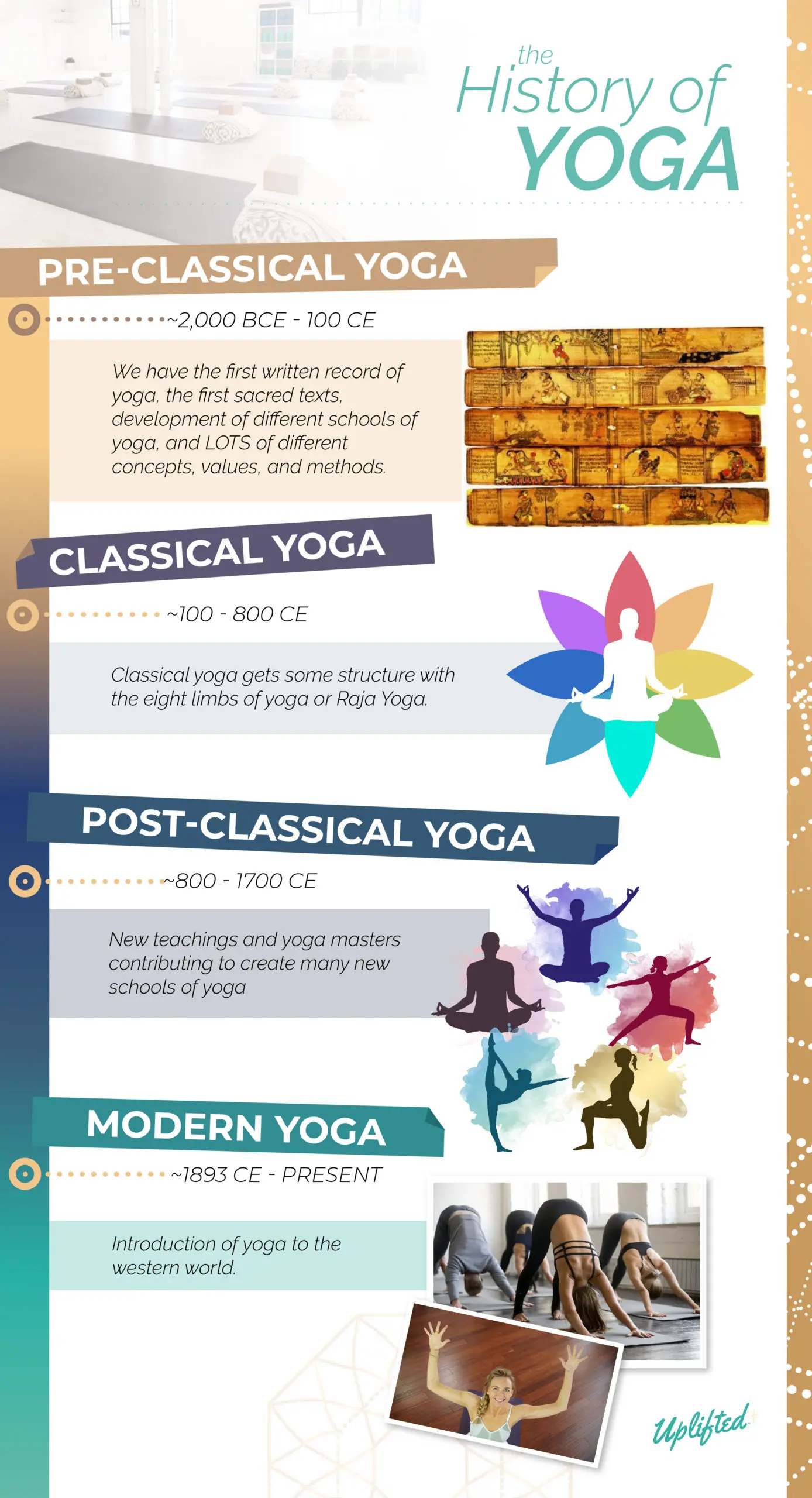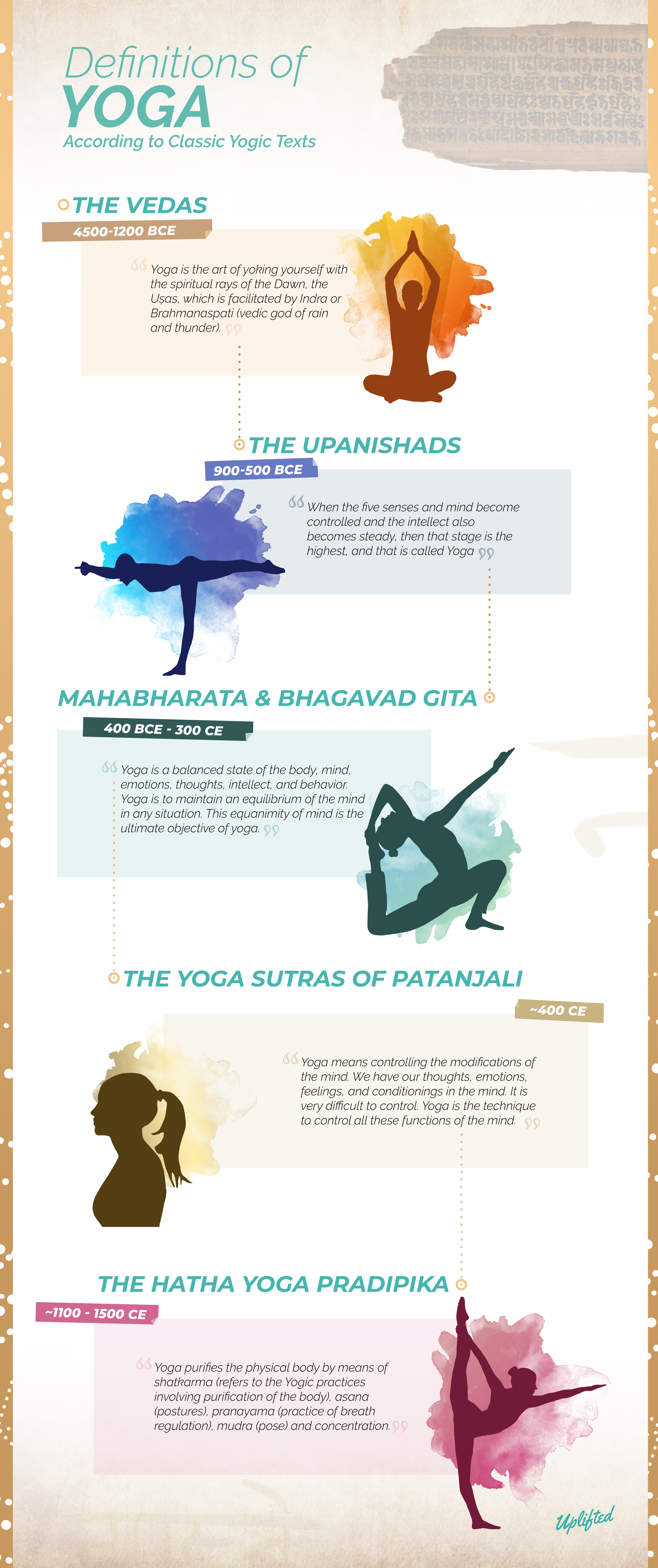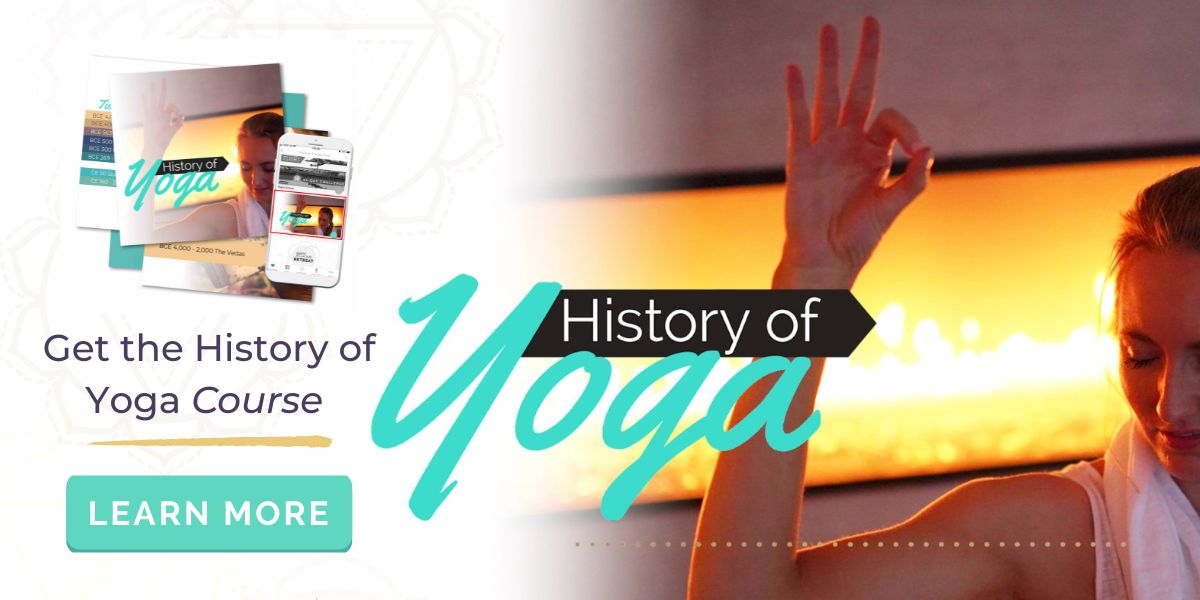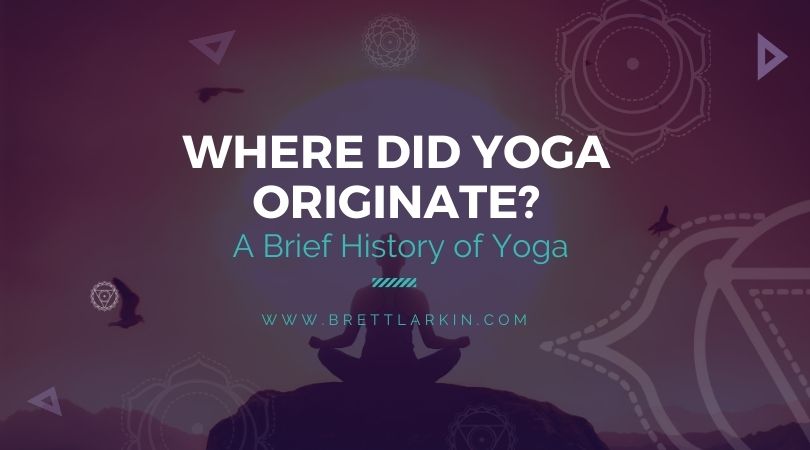
The term yoga is derived from the Sanskrit word ‘yuj’ meaning “to unite.” With yoga, it conveys the sense of union – the linking or joining of the individual self with the higher self. So where does the actual practice and theory originate?
The theory of yoga (along with various physical postures or asanas) that has gained global attention goes back to the Indus Valley Civilization (c. 3500-1500 BCE) in the northwestern regions of South Asia.
Over the past 5,000 years give or take, it’s understandably changed a lot so what we know as yoga today is vastly different from the way people practiced it in ancient times. They definitely didn’t have online yoga classes back then LOL
Want to know more? Keep reading! We’ll walk through the history of yoga as well as the true definitions of yoga according to the ancient texts.
The History of Yoga
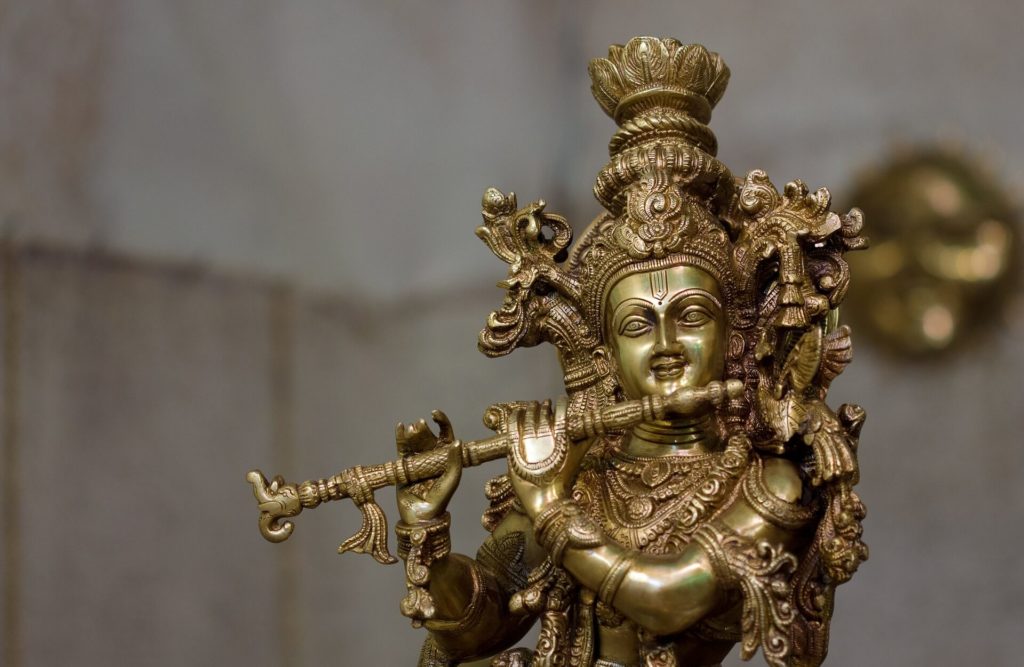
Considering yoga has been around for so long, we’ll just do a quick crash course of 2,500 to 5,000 years of history here. Essentially, we got five main time chunks of yoga:
- The Beginning (~? – 1,500 BCE): This is a little wishy-washy because it’s so old and so much of it was oral tradition, you just get lots of different takes of this. We won’t go into this too much, but just know that many consider there to be a pre-pre-classical time.
- Pre-Classical Yoga (~2,000 BCE – 100 CE): Developing and spreading yogic texts and ideations including the vedas, Upanishads, and Bhagavad-Gita.
- Classical Yoga (~100 – 800 CE): The creation of Raja Yoga and eight-fold yoga.
- Post-Classical Yoga (~800 – 1700 CE): The many schools of yoga that began after Raja Yoga.
- Modern Yoga (~1893 CE – present): The primary beginning of introducing yoga to the western world.
How yoga actually started is a bit fuzzy, it being 5,000 years ago and all (some researchers even think it could be up to 10,000 years old!). Researchers know a form of yoga was at least present in the Indus Valley Civilization because of soapstone seals and fossil remains with different yogic symbols and poses on them.
Some yogic lore says that Shiva, or Sage Adiyogi, was the first yogi and taught his yogic ways to seven sages in the Himalayas, who then spread the practices around the world.
Now, let’s get into the more nitty-gritty details for each period from pre-classical to where we’re at with yoga today.
Pre-Classical Yoga
The Pre-Classical era of yoga spans an extensive period of around 2,000 years, so it’s understandable there’s a lot going on here. We have the first written record of yoga, the first sacred texts, development of different schools of yoga, and LOTS of different concepts, values, and methods.
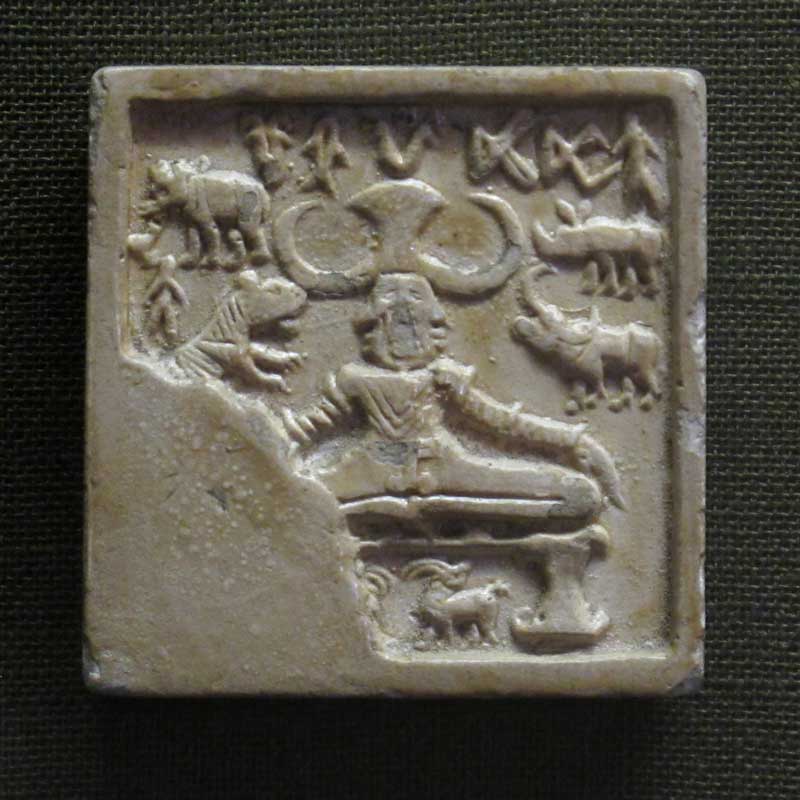
To begin, the term yoga first appears in written text in the Rig Veda, one of the oldest sacred books.
According to World History Encyclopedia, the Vedas (including the Rig Veda, Sama Veda, Yajur Veda, and Atharva Veda) are a compilation of religious texts about Hinduism. Within each veda has four different sections and the last section, Upanishads, in the Rig Veda is where yoga comes in, discussing the Brahmans’ practices and beliefs.
Then there’s the Bhagavad Gita. Written around 500 BCE, The Bhagavad Gita is one of the most recognized of the Yogic scriptures. It’s basically a story outlining many of the biggest lessons that Hinduism offers.
Two other great texts that came out of this era were the Ramayana and the Mahabharata. These national epics illustrated several different schools of yoga which taught all different techniques, concepts, values, and methods around yoga and deep meditation.
Mix all these texts and schools together, and you get pre-classical yoga: A multitude of teachings that create a slightly obscured and contradictory pathway.
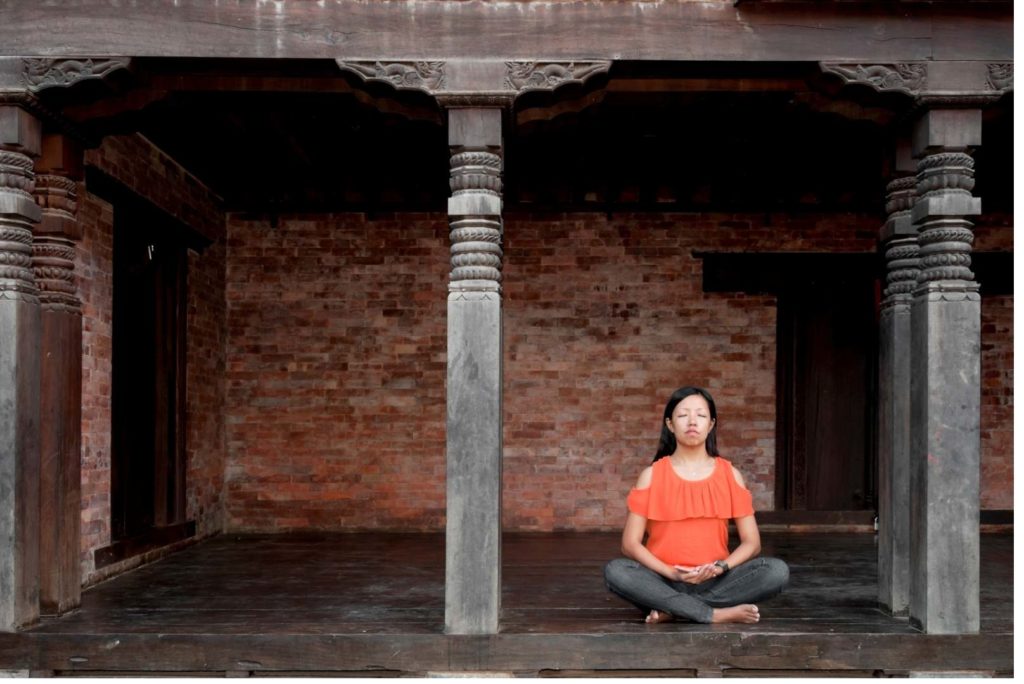
Classical Yoga
After the pre-classical era comes — you guessed it — the classical era of yoga. While pre-classical yoga was a bit all over the place, classical yoga got some structure with the eight limbs of yoga or Raja Yoga.
Where did these yoga concepts come from? Patanjali’s Yoga Sutras – a Sanskrit text with just under 200 aphoristic statements.
While historians don’t know the exact timing for when Patanjali wrote the Yoga Sutra, many believe it was probably written sometime in the second century (though estimates range everywhere from 500 BCE to 400 CE).
Patanjali’s “eight limbs” created a road to Samadhi or enlightenment. The text was hugely influential and you’ve likely seen aspects of it in your modern yoga practice whether you know it or not…
…“asana” being one of the limbs and virtually the only limb practiced in the western world today.
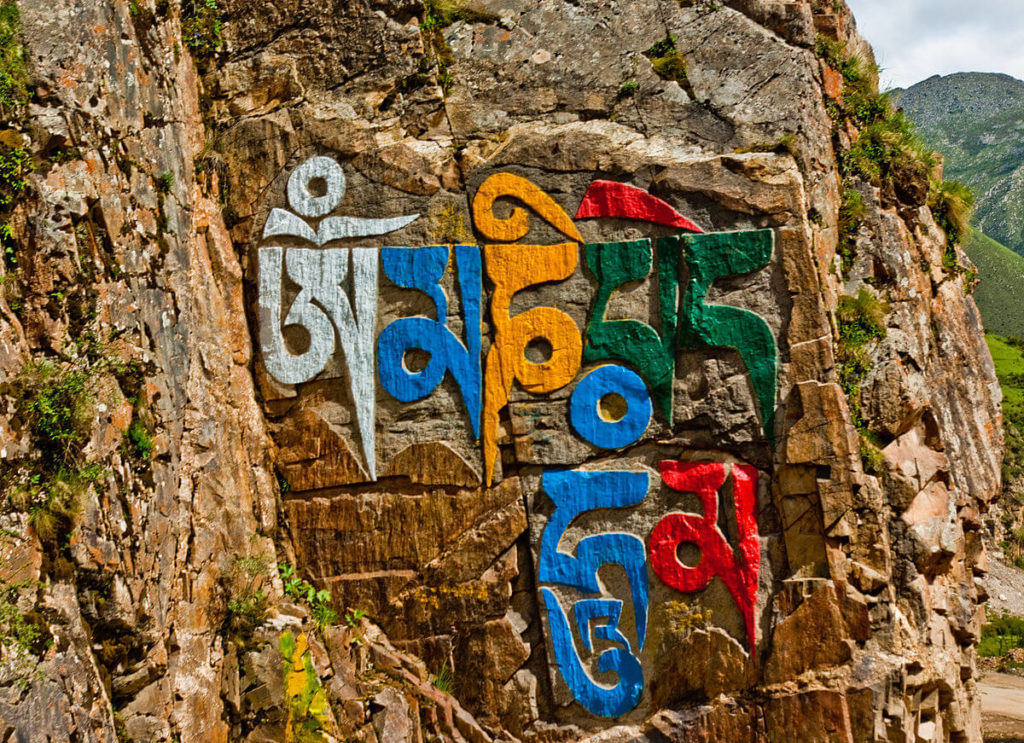
Post-Classical Yoga
Post classical yoga covers a big chunk of time again (almost 1,000 years). You’ve got a bunch of new teachings and yoga masters contributing to create many new schools of yoga.
The biggest takeaway from this period? Creating the understanding that the physical body is actually important and can be a way to find enlightenment. Unlike previous practices that tended to disregard the physical body, yoga masters during this time sought ways to improve the body — some even believed they could alter their body enough to make it immortal.
Sound familiar to some Hatha and Tantra yoga teachings you’ve learned already? That’s because this era was really the start of those branches of yoga.
These “new” principles were a large part of the deeper study and practice of yoga that still exists today.
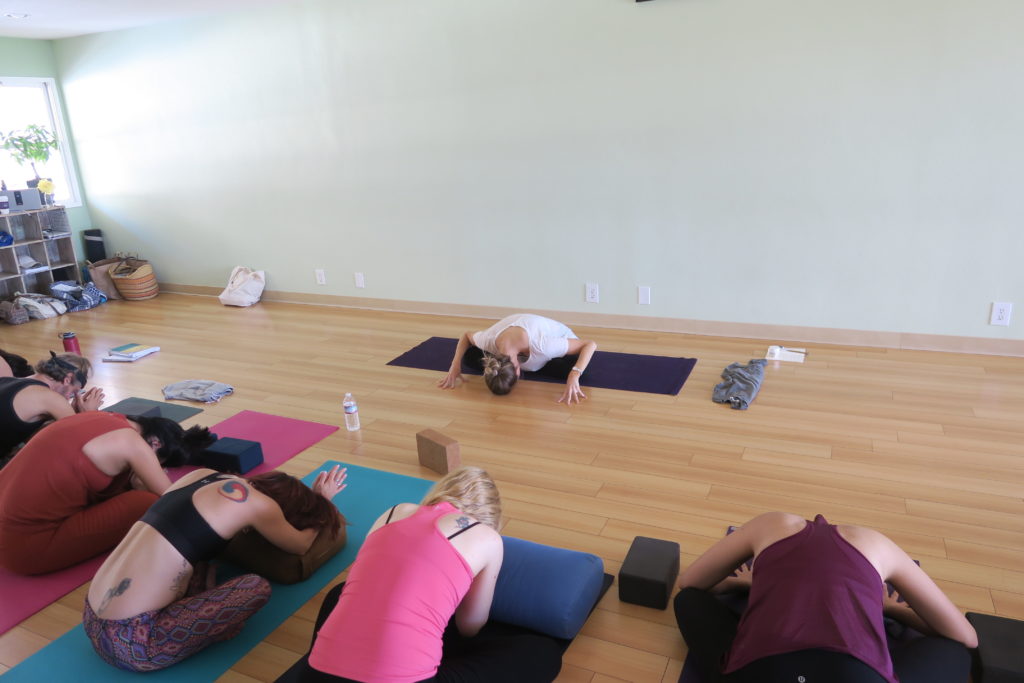
Modern Yoga
The modern yoga era started when yoga started making its way into the western world. Most sources note the start of this period as 1893 when Swami Vivekananda lectured about yoga at the Parliament of Religions in Chicago. Swami Vivekananda was basically the star of the party at the parliament and opened a passageway for yoga into the west.
From then on, more yoga masters came into the western world, spreading the different concepts of yoga – especially Hatha Yoga. Meanwhile, Hatha Yoga continued to gain traction in India with opening Hatha Yoga schools, teaching students, writing books on yoga, and generally spreading the knowledge.
A few of the other most influential yogis in spreading yoga around the world include Paramahansa Yogananda, Yogendra Mastamani,T. Krishnamacharya and Jiddu Krishnamurti.
Yoga hit the mainstream in the west with yogini Indra Devi’s Hollywood yoga studio in 1947 where she trained many celebrities. From then on, it’s a whirlwind of influential yoga teachers who have continued to spread and redefine what yoga means today.
Definitions of Yoga According to Classic Yogic Texts
Now that you know where and when these ancient texts and teachings on yoga came about. What did they actually say? Well, let’s dig into it a bit more!
The Vedas (4500-1200 BCE)
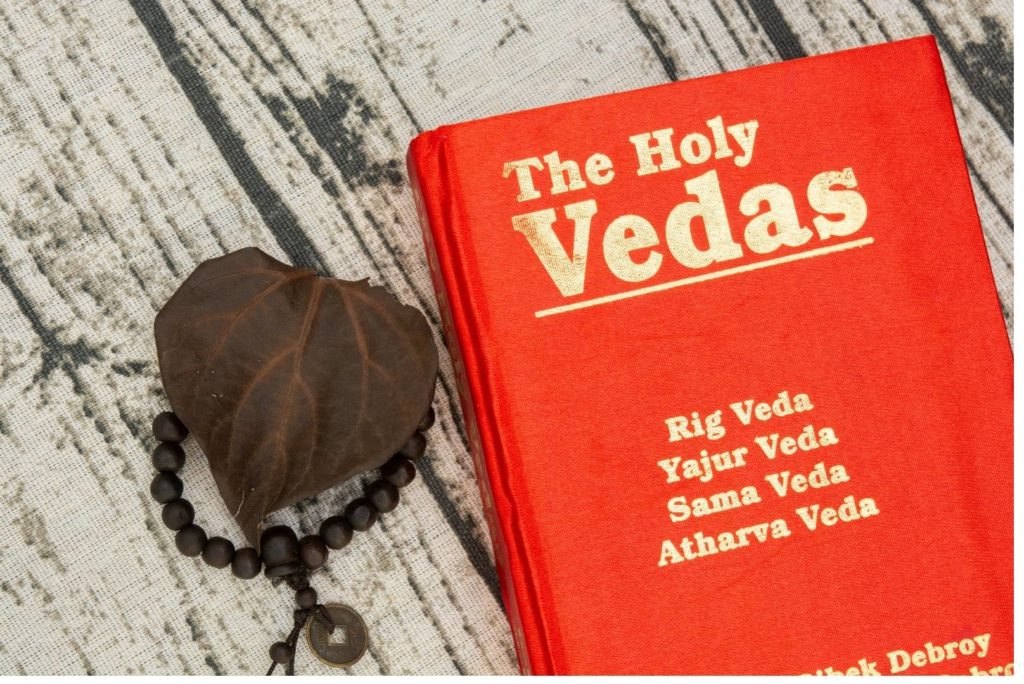
According to the Vedas:
“Yoga is the art of yoking yourself with the spiritual rays of the Dawn, the Uṣas, which is facilitated by Indra or Brahmaṇaspati (vedic god of rain and thunder).”
The name Veda comes from the Sanskrit root vid, which means “knowledge” and these texts are recognized as the most sacred and treasured texts of India. I already defined Vedas but if you need a reminder: they are a compilation of religious texts about Hinduism.
As I mentioned, yoga comes up in the Rig Veda (one of the four texts of the Vedas)
The Upanishads (900-500 BCE)
According to the Upanishads:
“When the five senses and mind become controlled and the intellect also becomes steady, then that stage is the highest, and that is called Yoga”
According to Yoga Basics, “The word Upanishad is usually interpreted as ‘sitting down beside.’” It is possible to split this Sanskrit word into three sections and translate it as “upa” meaning close, “ni” as down, and “shad” as sitting.
The sense of the word, therefore, confers the purpose of these texts to transfer knowledge and wisdom directly from teacher to student.
The Upanishads are actually a section in each of the Vedas and it is the Upanishads that have transferred the Vedas’ profound knowledge into practical and personal teachings, which contain many direct and indirect references to yoga.
Mahabharata and Bhagavad Gita (400 BCE – 300 CE)

According to these scriptures:
“Yoga is a balanced state of the body, mind, emotions, thoughts, intellect, and behavior. Yoga is to maintain an equilibrium of the mind in any situation. This equanimity of mind is the ultimate objective of yoga.”
Mahabharata, written by Sage Vyasa, is one of the longest known epic poems composed of over 200,000 individual verse lines. In several passages of the Mahabharata, yoga practice is specifically stated. Vyasa mentions yoga in the Mahabharata in Bhishma Parvan (parvan are the category/episodes of Mahabharata) and refers to it as a method of philosophy in Shanti Parvan. In Mokshadharrna Parvan, Vyasa identifies yoga as a source of great psychic power.
Bhagavad Gita, the most important ancient text for yoga, is a part of the Mahabharata. The Bhagavad Gita is also known as the Philosophy of Creation, or Yoga Psychology. It includes solutions to the complexities of human life.
So where does yoga get mentioned? There’s a few places. The 4th chapter of Bhagavad Gita sloka 1 runs as follows: “The Lord (Srikrishna) said I taught this imperishable Yoga to Vivaswan; Vivaswan taught it to Manu; Manu taught it to Ikshvaku”. Sloka 46 of Chapter VI (on meditation) runs as follows: “The Yogi is thought to be superior to the ascetics, and even superior to men of knowledge (mere scholars); he is also superior to men-of-action; therefore (you strive to) be a Yogi, O Arjuna.”
The Yoga Sutras of Patanjali (~400 CE)
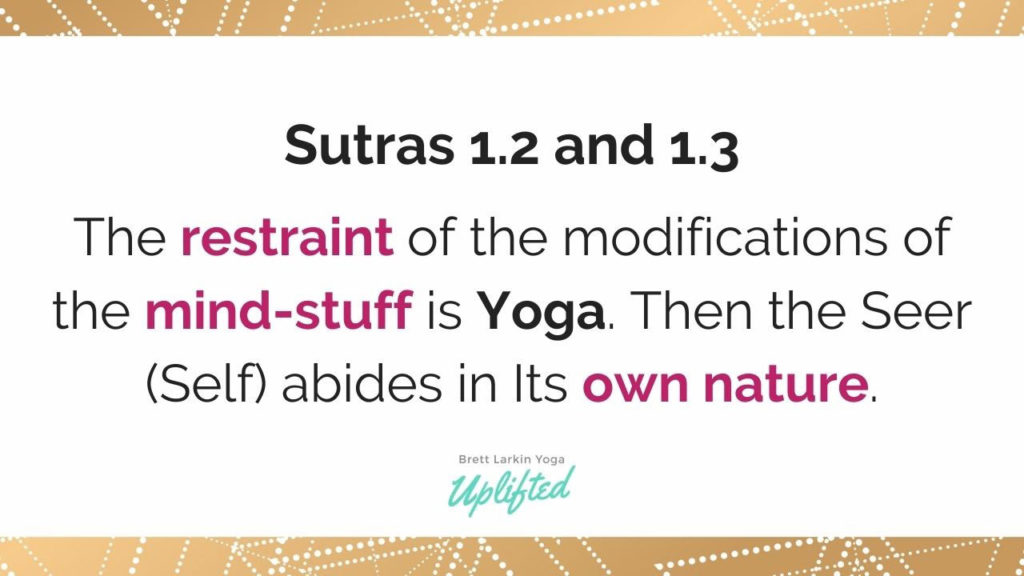
According to the classical definition by Sage Patanjali:
“Yoga means controlling the modifications of the mind. We have our thoughts, emotions, feelings, and conditionings in the mind. It is very difficult to control. Yoga is the technique to control all these functions of the mind.”
Patanjali’s Yoga (Otherwise known as Ashtanga Yoga of Patanjali or Raja Yoga) is a very systematic process of yoga written by great Sage Patanjali. He wrote Yoga Sutras to clarify the mechanism and systematic study of functional methods for awakening and extending the higher faculties of mind, intelligence and consciousness.
This is also where we get the eight limbs of yoga.
The Hatha Yoga Pradipika (~1100 – 1500 CE)
According to the Hatha Yoga Pradipika:
“Yoga purifies the physical body by means of shatkarma (refers to the Yogic practices involving purification of the body), asana (postures), pranayama (practice of breath regulation), mudra (pose) and concentration. “
The Haṭha Yoga Pradipika is a classic fifteenth-century Sanskrit manual on haṭha yoga. According to Yoga London, “The word Pradipika means to shed light, so we can think of the Hatha Yoga Pradipika as a guide to the mysterious world of Hatha Yoga.”
It consists of 389 verses in four chapters that describe topics including purification, posture, breath control, spiritual centers in the body, coiled power, force postures, energy, channels of the subtle body, and symbolic gestures.
Next Steps
- If you’re interested in practical kriya yoga as a way to improve your daily life and relationships, check out my Yoga for Self Mastery course.
- Order my Yoga Life book for a practical guide to creating balance in your life through yoga.
- Check out my YouTube channel and find some yoga classes that you can try out for yourself!
YOU MIGHT ALSO LIKE
- What is Kriya Yoga? The Philosophy and Practice
- Uddiyana Bandha: Tapping Into Your Deep Core
- 4 Reasons Hasta Bandha Is Essential To Your Yoga Practice
- Vitarka Mudra: What It Is and How Do You Use It?
- Shakti Mudra: What It Is and How Do You Do It?
- Garuda Mudra: What It Is and How Do You Use It?
- Kali Mudra: What It Is and How Do You Do It?
- Shunya Mudra: What It Is and How Do You Do It?
- Varuna Mudra: What It Is and How Do You Use It?
- Vayu Mudra: What It Is and How Do You Use It?
- Samana Vayu: The Energy of Balance & How to Access It
- Apana Vayu: The Energy of Release & Surrender
- Udana Vayu: The Ascending Wind
- Prana Vayu: The Breath of Vitality
- Vyana Vayu: The Energetic Secret to Flow
Learn how to do 11 of the most popular yoga poses correctly. Free video + PDF download.



